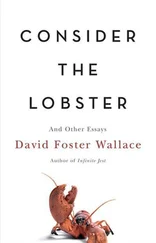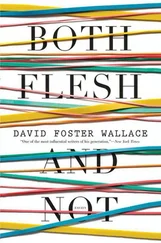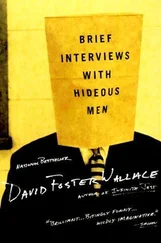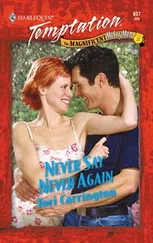Well, average Joe Briefcase has an OK brain, and deep down inside he knows, as we do, that there’s some kind of psychic shell-game going on in this system of conflicting whispers. But if it’s so bald a delusion, why do he and we keep watching in such high doses? Part of the answer — a part which requires discretion lest it slip into anti-TV paranoia — is that the phenomenon of television somehow trains or conditions our viewership. Television has become able not only to ensure that we watch but somehow to inform our deepest responses to what’s watched. Take jaded TV-critics, or our acquaintances who sneer at the numbing sameness of all the television they sit still for. I always want to grab these unhappy guys by the lapels and shake them until their teeth rattle and point to the absence of guns to their heads and ask why the hell they keep watching, then. But the truth is that there’s some complex high-dose psychic transaction between TV and Audience whereby Audience gets trained to respond to and then like and then expect trite, hackneyed, numbing television shows, and to expect them to such an extent that when networks do occasionally abandon time-tested formulas Audience usually punishes them for it by not watching novel shows in sufficient numbers to let them get off the ground. Hence the networks’ bland response to its critics that in the majority of cases — and until the rise of hip metatelevision you could count the exceptions on one hand—“different” or “high-concept” programming simply doesn’t get ratings. High-quality television cannot stand up to the gaze of millions, somehow.
Now, it is true that certain PR techniques — e.g. shock, grotesquerie, or irreverence — can ease novel sorts of shows’ rise to national demographic viability. Examples here might be the “shocking” A Current Affair , the “grotesque” Real People , the “irreverent” Married … with Children . But these programs, like most of those touted by the industry as “fresh” or “outrageous,” turn out to be just tiny transparent variations on old formulas.
It’s not fair to blame television’s shortage of originality on any lack of creativity among network talent. The truth is that we seldom get a chance to know whether anybody behind any TV show is creative, or more accurately that they seldom get a chance to show us. Despite the unquestioned assumption on the part of pop-culture critics that television’s poor old Audience, deep down, “craves novelty,” all available evidence suggests, rather, that the Audience really craves sameness but thinks, deep down, that it ought to crave novelty. Hence the mixture of devotion and sneer on so many viewerly faces. Hence also the weird viewer complicity behind TV’s sham “breakthrough programs”: Joe Briefcase needs that PR-patina of “freshness” and “outrageousness” to quiet his conscience while he goes about getting from television what we’ve all been trained to want from it: some strangely American, profoundly shallow, and eternally temporary reassurance .
Particularly in the last decade, this tension in the Audience between what we do want and what we think we ought to want has been television’s breath and bread. TV’s self-mocking invitation to itself as indulgence, transgression, a glorious “giving in” (again, not exactly foreign to addictive cycles) is one of two ingenious ways it’s consolidated its six-hour hold on my generation’s cojones. The other is postmodern irony. The commercials for Alf ’s Boston debut in a syndicated package feature the fat, cynical, gloriously decadent puppet (so much like Snoopy, like Garfield, like Bart, like Butt-Head) advising me to “Eat a whole lot of food and stare at the TV.” His pitch is an ironic permission-slip to do what I do best whenever I feel confused and guilty: assume, inside, a sort of fetal position, a pose of passive reception to comfort, escape, reassurance. The cycle is self-nourishing.
guilty fictions
Not, again, that the cycle’s root conflict is new. You can trace the opposition between what persons do and ought to desire at least as far back as Plato’s chariot or the Prodigal’s return. But the way entertainments appeal to and work within this conflict has been transformed in televisual culture. This culture-of-watching’s relation to the cycle of indulgence, guilt, and reassurance has important consequences for U.S. art, and though the parallels are easiest to see w/r/t Warhol’s Pop or Elvis’s Rock, the most interesting intercourse is between television and American literature.
One of the most recognizable things about this century’s postmodern fiction has always been the movement’s strategic deployment of pop-cultural references — brand names, celebrities, television programs — in even its loftiest High Art projects. Think of just about any example of avant-garde U.S. fiction in the last twenty-five years, from Slothrop’s passion for Slippery Elm throat lozenges and his weird encounter with Micky Rooney in Gravity’s Rainbow , to “You” ’s fetish for the New York Post ’s COMA BABY feature in Bright Lights, Big City , to Don DeLillo’s pop-hip characters saying stuff to each other like “Elvis fulfilled the terms of the contract. Excess, deterioration, self-destructiveness, grotesque behavior, a physical bloating and a series of insults to the brain, self-delivered.” 11The apotheosis of the pop in postwar art marked a whole new marriage between High and Low culture. For the artistic viability of postmodernism was a direct consequence, again, not of any new facts about art, but of facts about the new importance of mass commercial culture. Americans seemed no longer united so much by common beliefs as by common images: what binds us became what we stand witness to. Nobody sees this as a good change. In fact, pop-cultural references have become such potent metaphors in U.S. fiction not only because of how united Americans are in our exposure to mass images but also because of our guilty indulgent psychology with respect to that exposure. Put simply, the pop reference works so well in contemporary fiction because (1) we all recognize such a reference, and (2) we’re all a little uneasy about how we all recognize such a reference.
The status of Low-cultural images in postmodern and contemporary fiction is very different from those images’ place in postmodernism’s artistic ancestors, e.g. the “dirty realism” of a Joyce or the ur-Dadaism of something like Duchamp’s toilet sculpture. Duchamp’s aesthetic display of that vulgarest of appliances served an exclusively theoretical end: it was making statements like “The Museum is the Mausoleum is the Men’s Room,” etc. It was an example of what Octavio Paz calls “Meta-irony,” 12an attempt to reveal that categories we divide into superior/arty and inferior/vulgar are in fact so interdependent as to be coextensive. The use of Low references in a lot of today’s High literary fiction, on the other hand, serves a less abstract agenda. It is meant (1) to help create a mood of irony and irreverence, (2) to make us uneasy and so “comment” on the vapidity of U.S. culture, and (3) most important, these days, to be just plain realistic.
Pynchon and DeLillo were ahead of their time. Today, the belief that pop images are basically just mimetic devices is one of the attitudes that separates most U.S. fiction writers under c. 40 from the writerly generation that precedes us, reviews us, and designs our grad-school curricula. This generation gap in conceptions of realism is, again, TV-dependent. The U.S. generation born after 1950 is the first for whom television was something to be lived with instead of just looked at. Our elders tend to regard the set rather as the flapper did the automobile: a curiosity turned treat turned seduction. For younger writers, TV’s as much a part of reality as Toyotas and gridlock. We literally cannot imagine life without it. We’re not different from our fathers in that television presents and defines our contemporary world. Where we are different is that we have no memory of a world without such electric definition. This is why the derision so many older fictionists heap on a “Brat Pack” generation they see as insufficiently critical of mass culture is at once understandable and misguided. It’s true that there’s something sad about the fact that David Leavitt’s short stories’ sole description of some characters is that their T-shirts have certain brand names on them. But the fact is that, for most of Leavitt’s educated young readership, members of a generation raised and nourished on messages equating what one consumes with who one is, Leavitt’s descriptions really do do the job. In our post-1950s, inseparable-from-TV association pool, brand loyalty really is synecdochic of character; this is simply a fact.
Читать дальше












